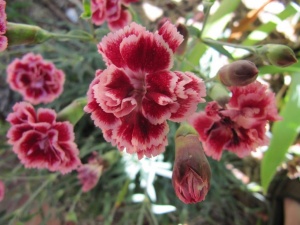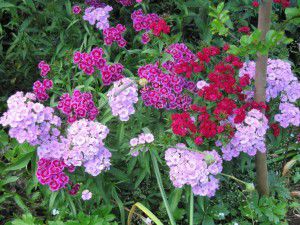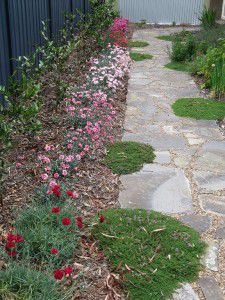SOME of the softest and most delicate looking plants – often termed English cottage garden plants – belie their hardiness.

The stunning new Dianthus “Sugar Plum”.
With these rare exceptions, every plant since that time has been introduced into Britain and it is only due to the long period of growing there that they have been termed as “English”.
The so-called English Box or Buxus was only introduced into Britain from the Mediterranean region by the Romans. Pollens, which can survive for thousands of years, have enabled botanists to determine the exact variety and origin.
It is unfortunate that many folk shun “English” plants in gardens here because many, especially the mediterranean-region plants, are ideally suited to our harsh climate with long periods of dry.
Another example so beloved of cottage gardeners is the Dianthus family, commonly known as “pinks”. My edition of the plant dictionary “Hortus Third” lists more than 200 varieties and cultivars – and this is the 1976 edition! There are possibly another 100 that have been bred since then.

Old-fashioned Dianthus barbatus or Sweet William.
Many long-time gardeners will be familiar with the old favourites such as Dianthus “Doris” or D. “Mrs Sinkins”. And now there is the prospect of a new range of Dianthus, grown by the wholesale nursery Plant Growers of Australia and distributed through local garden centres.
The PGA’s collection of Dianthus is recognised worldwide as the leading award-winning collection through 75 years of dedication to excellence and plant breeding.
This collection comes direct from the world’s only commercial Dianthus specialists known as Whetman Pinks. I have illustrated here one of my favourites, Dianthus “Sugar Plum”, with its rich colours. Contrasting this is the white with a splash of red in the centre of D. “Coconut Sundae”. Other fun names include D. “Slap and Tickle”, D. “Passion” and D. “Waterloo Sunset”.

Here’s Roy’s collection of new Dianthus. Until I created this garden, Roy’s only role was mowing. Now, with his new garden and retirement, this has meant a whole new interest in gardening and life. Roy can be seen still mowing his new lawn, but in addition he’s also dead-heading the Dianthus or the Callistemons, feeding his plants – using only organic plant nutrients – plus growing and harvesting a great range of herbs. And I know that Patricia thinks it is just great seeing Roy’s interest in their garden.
AT flower shows, like the Horticultural Society of Canberra’s recent successful spring shows, even seasoned gardeners find out about new plants.
The UK’s Royal Horticultural Society has found that the more long-term gardeners (and even more so those new to gardening) immerse themselves in gardening, the more their eyes are opened.
Often it is the old-fashioned plants that come back into their own, especially perennials now reappearing at garden centres or on plant stalls at flower shows or fetes.
Likewise, it is great to see the increased interest in community gardens, originally known as allotments, which came into prominence during the wars and the “Dig for Victory” campaigns.
After World War II, interest in allotments waned and they largely fell into disuse.
However, in Britain there has been an upsurge in the demand for them and, indeed, we are seeing a similar experience in Canberra now with waiting lists for sites. The Canberra Organic Garden Growers Association operates 12 gardens here.
More information at cogs.asn/communitygardens
The post The hardy, softy plants appeared first on Canberra CityNews.